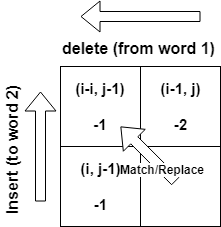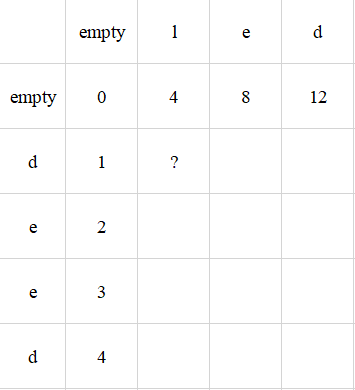Approximate String Matching
Approximate String Matching
For convenience, we use (m,i,d,r) to infer (matching, insertion, deletion, replacement)
Neighborhood Search
In neighborhood, there are operations: i,d,r. Linux’s agrep is one of the most famous fast neighborhood search tool. A simple example is given below:
agrep -2 -w word dictionary.txt
“-2” indicates a 2-neighborhood, which means at most 2 operations (i,d,r) can be performed. “-w” indicates the matching string must be a word. All 2-neighborhood words of “word” from the dictionary.txt file will be returned.
Edit Distance
A “score” or “distance” will be returned by the according algorithms.

When determine a new value in the grid, the edit distance algorithms will compare the neighboring 3 pre-calculated values with the corresponding operation score/penalty.
The three choices are:
Global Edit Distance
let us assume the first word is “led” and second word is “deed”, and (m,i,d,r) = (-3,1,4,2)
Since m < i,d,r the algorithm will select the minimum among the three choices. In other words, if (m,i,d,r) = (1,-1,-1,-1), the maximum will be selected.

Let us calculate the question marked grid:
\[(i,j-1) + deletion = 1 + 4 = 5\] \[(i-1,j) + insertion = 4 + 1 = 5\]Since “l” != “d”,
\[(i-1,j-1) + match/replacement = 0 + 2 = 2\]Among which the minimum is 2, we fill the grid with 2, mark the operation and source:

P.S.
Needleman–Wunsch algorithm (m,i,d,r) = (1,-1,-1,-1) -> max()
Levenshtein distance (m,i,d,r) = (0,1,1,1) -> min()
Local Edit distance
For local edit distance, one more choice - 0 is created. LED algorithms are used to search for best substring matches. Like GEDs, max() when m > i,d,r or min() otherwise.
N-Grams
Let: A = “led”, B = “deed”.
N_Gram_distance = \(|A|+|B|-2|A\cap B|\)
Let us do a 2-gram distance.
2-GRAMS of A:
#l, le, ed, d#
and B:
#d, de, ee, ed, d#
There are 2 matches: ed and #d
2_Gram_distance = 4 + 5 - 2 * 2 = 5
Soundex
The steps for converting a word to soundex representation:
- Except for initial character, translate string characters according to soundex table.
- Remove duplicates (e.g. 4444 → 4)
- Remove 0s
- Truncate to four symbols
Consider a simple soundex table:
| symbols | soundex number |
|---|---|
| aeiouwy | 0 |
| bdgjlmnrvz | 1 |
| cfhkpqstx | 2 |
and a word “carter”:
- c01201
- c01201
- c121
- c121
So, the soundex representation of word “carter” is c121.